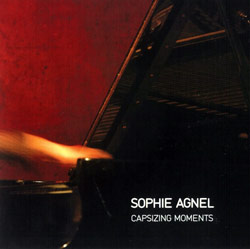
Everyone marvels over John Cage's groundbreaking use of prepared piano as "percussion orchestra" (an art he borrowed from one-time teacher, Henry Cowell), but he has less to say about creativity, more about necessity and frustration, on the matter: space (performance, rehearsal) and social issues are the initial reasons he chucked all his percussion inside the piano lid. "You can't get a group of people to work together in New York for any length of time, because they're all too busy making money... I had to give a concert of percussion music at the Museum of Modern Art... I found that I couldn't get a full rehearsal — ever. So I threw my energy and everything into the prepared piano" (Duckworth, Talking Music).
Though she has a willing cadre of collaborators (Phil Minton, Olivier Benoit), it is Sophie Agnel's "energy and everything", her time spent exploring tactile intricacies, language and relationships inside a wooden box, that sets her apart from other enthusiastic disciples who also seek originality in this well of non-tradition. Without her devotion to this otherworldly vein, performing it as a sans-net-to-catch-you soloist, this hour-long, unedited improvisation might come off as flat, verbose and pedestrian, not — as is the case — enthralling, technically admirable and natural.
Athletically navigating through a host of ideas and foreign objects (the sleeve is quick to note "solo piano with variable preparations, but no electronics"), Agnel begins with an intense, rumbling thud, a gesture that says "yes, Capsizing Moments is a fitting title; watch and listen as I keep this monstrous vessel-under-siege afloat." Gaining momentum, she maintains a polyrhythmic wooden creak, sustained metallic wiggles (aka aluminum ashtrays on strings) and low register roar, slowly introducing then removing various items from the sonic spectrum; gradually, the multiple patterns turn into a grooving ostinato of palm slaps and hammer strikes. At the fifteen minute mark, Agnel brushes the fibers and tendons of her soundboard to produce a bewitching five minute cadence of tinny, echoing feedback. Switching speeds with the next movement, Agnel first alternates between disconcerting, screeching harmonics and sawing vibrations then moves to a mix of idiomatic high-frequency trills, muted wood blocks and infrequent but tremulous staccato clusters.
However, the most engaging portion of the piece comes after a lugubrious build of rattles and pianissimo mouth whistle towards a bionic hammered dulcimer-like performance in the middle of the third movement. Agnel, gnashing and flexing, suddenly reduces the texture to a stark, skittish tinker bell. Amazingly, she juggles this with more harmonics, string plucks and twanging guitar-like bends, and ends the set with a series of miraculous tricks (i.e. gently purring bass horns, nearly intelligible voices, things you have to witness, live, to identify) she cleverly horded until now.
With prowess and invention, Agnel's work on Capsizing Moments may cement her place as heir to this instrument's misanthropic throne.
Comments and Feedback:



More Recent Reviews, Articles, and Interviews @ The Squid's Ear...


|

